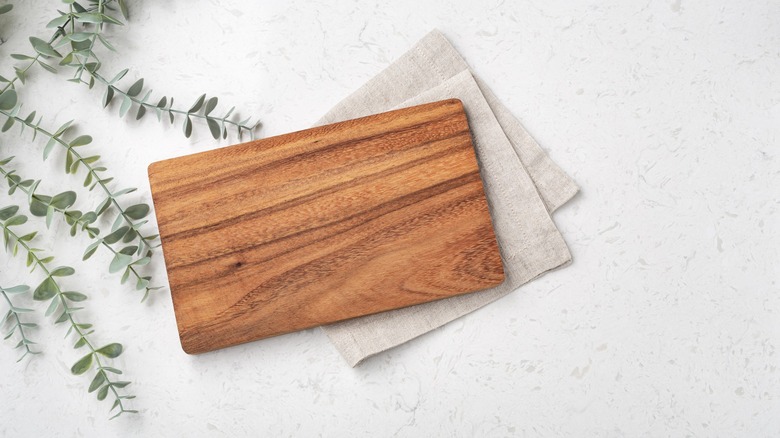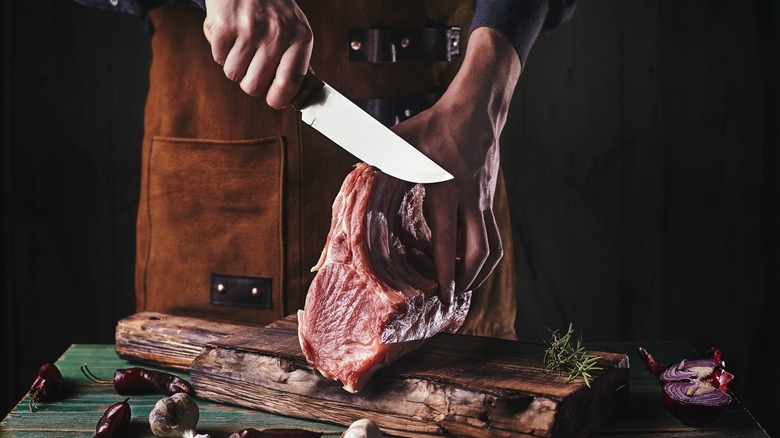When Cleaning Wood Cutting Boards, Stay Far Away From Cooking Oils
From carving a prime roast to serving up a charcuterie spread, wooden cutting boards are among the classiest tools in the kitchen. You'll want to keep something with that much panache safe and clean, keeping the wood away from water and other liquids that will damage and compromise the absorbent surface. Oils can provide a sleek layer of protection to your prized wooden cutting boards, but it's important to remember never to use cooking oils, even though their ubiquitousness in the kitchen makes them tempting.
That's because not all oils are the same. Varieties like vegetable, peanut, and olive oils are liquid fat, which means that, like other food, they can go bad. If stored properly, edible oils can last a lot longer than other ingredients in your kitchen, but they still have a shelf life and will eventually turn rancid, giving your fancy cutting board a decidedly unsophisticated smell. On the other hand, food-grade mineral oil, which is refined from petroleum sources, doesn't contain any fat that can degrade.
Why mineral oil works
It might sound strange to hear that mineral oil should have a spot in your pantry considering its varied non-food-related uses, but there's a further distinction between the different ways it's created and refined. The substance is used in the manufacturing of cosmetics, as a thermal conduction agent, and to lube up car gears. Highly refined bottles of mineral oil that don't contain carcinogenic chemicals work as a way to maintain cutting boards. These usually have labels that define the product as "food-grade mineral oil," "white mineral oil," or, most simply, "cutting board oil."
The oil works to coat the cutting board with a protective layer, shielding the wood from the damaging effects of water. Anyone who has mistakenly run their board through the dishwasher one too many times knows that too much water exposure can bend and warp the wood, eventually cracking and breaking it. Conversely, wood can also warp when it gets too dry, so the mineral oil serves an additional job of keeping the cutting board moisturized. Think of it like moisturizing your hands after you wash them with soap and water so they don't get dry and cracked.
Ways to preserve wood
Mineral oil isn't the only slippery substance that can keep your wooden cutting board fresh and healthy. Beeswax can also coat wood and keep water from slipping in, although it helps to mix mineral oil to help it seal into the wood since beeswax takes longer to dry. Coconut oil is usually a no-no since it can spoil like other fat oils. However, fractionated coconut oil, which undergoes a distillation process that removes the fatty acids, is suited for conditioning cutting boards. Unlike regular coconut oil, which solidifies due to the fat content, fractionated coconut oil is more liquid in nature and much easier to spread over the surface of a cutting board. Coconut oil may be more palatable to those looking for a plant-based option and has the added benefit of being vegan.
These lubricants will not only prolong the life of your cutting board, they'll also help it look fresh and shiny. A coating of oil will help protect the wood from staining and, in turn, will help sanitize the material against bacteria that can rot. You don't have to oil your board after every clean, either. A monthly coating after your usual clean should do the trick, which just requires swabbing a layer on with either a clean wash towel or your hands and letting it try for at least three hours. You'll be having holiday dinners and wine and cheese parties for years to come.



